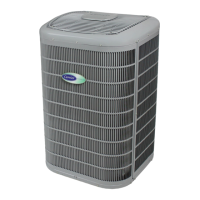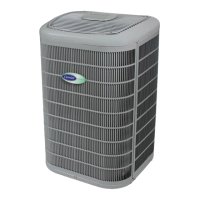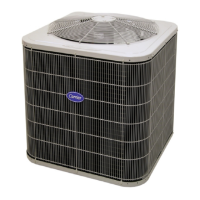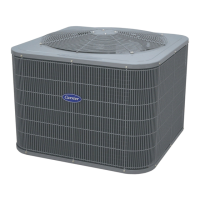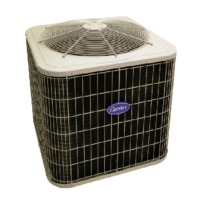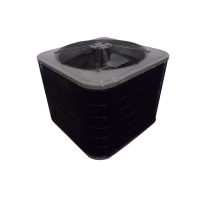Brown- Out Protection
If the line voltage is less than 187v for at least 4 seconds, the
contactor and fan relay are de-energized. Compressor and fan
operation are not allowed until voltage is a nfininmm of 190v. The
control will flash the appropriate fault code (see Table 7).
230V Line (Power Disconnect) Detection
If there is no 230v at the contactor when the indoor unit is powered
with a cooling or heating demand, the appropriate fault code is
displayed. Verify the disconnect is closed and 230v wiring is
connected to the unit.
Inverter Voltage Sensin_
The control board senses the presence or absence of 230 V through
the feedback from inverter. The control monitors the high voltage
to the inverter. Voltage should be present anytime the contactor is
energized and voltage should not be present when the contactor is
de-energized.
Temperature Thermistors
Thermistors are electronic devices which sense temperature. As the
temperature increases, the resistance decreases. Thermistors are
used to sense outdoor air (OAT), coil temperature (OCT) and the
suction line thermistor (OST) located between the reversing valve
and the accumulator.
Refer to Table 4 and Fig. 14 for resistance values versus
temperature.
Table 4 - Resistance Values versus Temperature
TEMPERATURE RESISTANCE(ohms)
25.0°C (77.0°F) 10.0 +/- 2.3%
0.0°C (32.0 ° F) 32.6 + / - 3.2%
-28.0°C (-18.4 ° F) 85.5 +/- 3.4%
THERMISTOR CURVE
90,
20 40 80 80 100 120
TEMPERATURE(DEG._
A91431
Fig. 14 - Thermistor Resistance Versus Temperature
If the outdoor air or coil thermistor should fail, the control will
flash the appropriate fault code (see Table 7.)
IMPORTANT: The outdoor air thermistor, coil thermistor and
suction thermistor should be factory mounted in the final
locations. Check to ensure thermistors are mounted properly
(See Fig. 15, 16 and 17).
Thermistor Sensor Comparison
The control continuously monitors and compares the outdoor air
temperature sensor and outdoor coil temperature sensor to ensure
proper operating conditions. The comparison is:
• In cooling if the outdoor air sensor indicates ->10 °F (->5.6 ° C)
warmer than the coil sensor (or) the outdoor air sensor indicates
->20 °F (-> 11 ° C) cooler than the coil sensor, the sensors are out
of range.
• In heating if the outdoor air sensor indicates ->35 °F (-> 19.4 ° C)
warmer than the coil sensor (or) the outdoor air sensor indicates
->10°F (-> 5.6°C) cooler than the coil sensor, the sensors are out
of range.
If the sensors are out of range, the control will flash the appropriate
fault code as shown in Table 7.
The thermistor comparisons are not performed during low ambient
cooling or defrost operation.
Failed Thermistor Default Operation
Factory defaults have been provided in the event of failure of
outdoor air thermistor (OAT) and/or outdoor coil thermistor
(OCT).
If the OAT sensor should fail, low ambient cooling will not be
allowed and the one-minute outdoor fan off delay will not occur.
Defrost will be initiated based on coil temperature and time.
If the OCT sensor should fail, low ambient cooling will not be
allowed. Defrost will occur at each time interval during heating
operation, but will terminate after 5 minutes.
If there is a thermistor out-of-range error, defrost will occur at
each time interval during heating operation, but will terminate after
5 minutes.
Count the number of short and long flashes to determine the
appropriate flash code. Table 7 gives possible causes and actions
related to each error.
Outdoor Coil Thermistor
The outdoor coil thermistor is a 10Kohm resistor used for nmltiple
system operations. It provides the coil/liquid line temperature to
the heat pump board and user interface. Low ambient operation,
defrost initiation, defrost termination and assistance with OAT
temperature measurement of some of the functions. The sensor
must be securely mounted to the tube connecting the EXV and
distributor. See Fig. 15 for proper placement. See Table 4 for
proper resistances.
OATThermistor must be
locked in place with
spherical nib endfacing
towards the front of the
f ---
_ ..... / 1
Al1142
Fig. 15 - OAT Thermistor Location (Bottom of Control Box)
Al1143
Fig. 16 - Outdoor Coil Thermistor (OCT) Attachment
(On Distributor Tube)
13
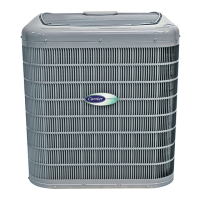
